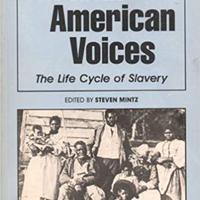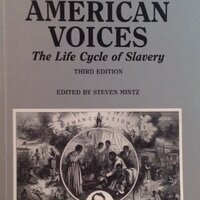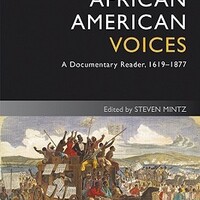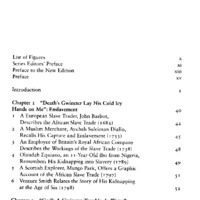-
Title
-
African American Voices (ed. Mintz, 4th ed.)
-
This edition
-
"African American Voices: A Documentary Reader, 1619-1877." Ed. Stephen Mintz. 4th ed. Malden, MA: Wiley-Blackwell, 2009. xiv+241 pp.
-
Other editions, reprints, and translations
-
● "African American Voices: The Life Cycle of Slavery." Ed. Steven Mintz. St. James, NY: Brandywine Press, 1993. ix+178 pp.
-
 African American Voices (ed. Mintz)
African American Voices (ed. Mintz)
-
● "African American Voices: The Life Cycle of Slavery." Ed. Steven Mintz. Rev. ed. St. James, NY: Brandywine Press, 1996. ix+212 pp.
-
● "African American Voices: The Life Cycle of Slavery." Ed. Stephen Mintz. 2nd ed. St. James, NY: Brandywine Press, 1999. xi+227 pp.
-
 African American Voices (ed. Mintz, 2nd ed.)
African American Voices (ed. Mintz, 2nd ed.)
-
● "African American Voices: The Life Cycle of Slavery." Ed. Stephen Mintz. 3rd ed. St. James, NY: Brandywine Press, 2004. xi+233 pp.
-
 African American Voices (ed. Mintz, 3rd ed.)
African American Voices (ed. Mintz, 3rd ed.)
-
Table of contents
-
(4th ed. 2009):
List of figures
Series Editor's Preface
Preface to the New Edition
Preface
Introduction
Chapter 1: "Death's Gwineter lay his cold icy hands on me": Enslavement
● A European slave trader, John Barbot, describes the African slave trade (1682)
● A Muslim merchant, Ayubah Suleiman Diallo, recalls his capture and enslavement (1733)
● An employee for Britain's Royal African Company describes the workings of the slave trade (1738)
● Olaudah Equiano, an eleven-year-old Ibo from Nigeria, remembers his kidnapping into slavery (1789)
● A Scottish explorer, Mungo Park, offers a graphic account of the African slave trade (1797)
● Venture Smith relates the story of his kidnapping at the age of six (1798)
Chapter 2: "God's A-Gwineter trouble de water": The Middle Passage and Arrival
● A European sailor, James Bardot, Jr., describes a shipboard revolt by enslaved Africans (1700) (61-63)
● Olaudah Equiano, who was born in eastern Nigeria, describes the horrors of the Middle Passage (1789)
● A doctor, Alexander Falconbridge, describes conditions on an English slaver (1788)
● Olaudah Equiano describes his arrival in the New World (1789)
● An English physician, Alexander Falconbridge, describes the treatment of newly-arrived slaves in the West Indies (1788)
Chapter 3: "A change is gonna come": Slavery in the Era of the American Revolution
● The poet Phillis Wheatley writes about freedom and equal rights (1774) [new to this edition]
● Massachusetts slaves petition for freedom (1774)
● Virginia's Royal Governor promises freedom to slaves who join the British army (1775)
● Virginia's assembly denounces Lord Dunmore's proclamation (1775)
● Connecticut slaves petition for freedom (1779)
● Boston King, a black loyalist, seeks freedom behind British lines (1798)
● A participant in Gabriel's Rebellion explains why he took part in the attempted insurrection (1812)
● Gabriel's brother explains the rebellion's objectives (1800)
● President Thomas Jefferson tries to arrange for the deportation of men involved in Gabriel's Rebellion (1802)
Chapter 4: "We raise de Wheat, Dey gib us the Corn": Conditions of life
● A free black kidnapped from New York, Solomon Northrup, describes the working conditions of slaves on a Louisiana cotton plantation (1853)
● Charles Ball, a slave in Maryland, compares working conditions on tobacco and cotton plantations (1858)
● Josiah Henson, a Maryland slave, describes slave housing, diet, and clothing (1877)
● Francis Henderson, who was a slave near Washington, D.C., describes living conditions under slavery (1856)
● A South Carolina slave, Jacob Stroyer, recalls the material conditions of slave life (1898)
● A former Virginia slave, James Martin, remembers a slave auction (1937)
● Elizabeth Keckley, born into slavery in Virginia, describes a slave sale (1868) [new to this edition]
Chapter 5: "Nobody knows the trouble I've seen": Visual history of Slavery [this whole section is new to this edition]
● The inspection and sale of an African captive along the West African coast (1854)
● An illustration of the layout of a slave ship (1807)
● Enslaved Africans on the deck of a slave ship (1860)
● Two slave sale advertisements (1859, c. 1780s)
● A fugitive slave advertisement (1774)
● An illustration of a slave auction at Richmond, Virginia (1856)
● Five generations of a slave family (c.1850s)
● An engraving illustrating Nat Turner's insurrection (c.1831)
● A plantation manual offers detailed instructions to overseers about how they are to treat nursing mothers (1857-1858)
● African Americans in Baltimore celebrate the ratification of the Fifteenth Amendment, extending the vote to black men (1870)
Chapter 6: "O Mother don't you weep": Women, Children, and families
● Harriet Jacobs describes her efforts to escape verbal, physical, and sexual abuse (1861) [new to this edition]
● Bethany Veney describes how she aborted a slave sale (1889) [new to this edition]
● Susie King Taylor escapes to freedom during the Civil War (1902) [new to this edition]
● Jacob Stroyer recalls the formative experiences of his childhood (1898)
● James W. C. Pennington analyzes the impact of slavery upon childhood (1849)
● Lunsford Lane describes the moment when he first recognized the meaning of slavery (1842)
● Laura Spicer learns that her husband, who had been sold away, has taken another wife (1869)
● An overseer attempts to rape Josiah Henson's mother (1877)
● Lewis Clarke discusses the impact of slavery on family life (1846)
Chapter 7: "Go home to my lord and be free": Religion
● Olaudah Equiano, from eastern Nigeria, describes West African religious beliefs and practices (1789)
● Charles Ball, a slave in Maryland, remembers a slave funeral, which incorporated traditional African customs (1837)
● Peter Randolph, a former Virginia slave, describes the religious gatherings slaves held outside of their masters supervision (1893)
● Henry Bibb, who toiled in slavery in Kentucky, Louisiana, and Arkansas, discusses ``conjuration'' (1849)
Chapter 8: "Oppressed so hard they could not stand": Punishment
● Frederick Douglass, a fugitive slave from Maryland, describes the circumstances that prompted masters to whip slaves (1845)
● Elizabeth Keckley of Virginia describes a lashing she received (1868) [new to this edition]
● John Brown, born into slavery in Virginia, has bells and horns fastened on his head (1855)
● William Wells Brown, a Missouri slave driver, is tied up in a smokehouse (1847)
● Moses Roper, a slave in Georgia and the Carolinas, is punished for attempting to run away (1837)
● A Kentucky slave, Lewis Clarke, describes the implements his mistress used to beat him (1846)
Chapter 9: "Let my people go": Resistance and flight
● Frederick Douglass resists a slave breaker (1845)
● Nat Turner, a Baptist preacher in Virginia, describes his revolt against slavery (1831)
● Harriet Tubman, a former Maryland slave, sneaks into the South to free slaves (1863, 1865)
● Harriet Tubman's life and methods for liberating slaves (1863, 1865) [new to this edition]
● Levi Coffin, the "President" of the Underground Railroad, assists fugitives to escape slavery (1876) [new to this edition]
● A Maryland slave, Margaret Ward, follows the North Star to freedom (1879)
● Frederick Douglass borrows a sailor's papers to escape slavery (1855, 1895)
● Henry ``Box'' Brown of Virginia escapes slavery in a sealed box (1872)
● Margaret Garner, a fugitive slave from Kentucky, kills her daughter rather than see her returned to slavery (1876)
Chapter 10: "The walls came tumblin' down": Emancipation
● Hannah Johnson, the mother of a black soldier, pleads with President Abraham Lincoln not to rescind the Emancipation Proclamation (1863)
● Private Thomas Long assesses the meaning of black military service during the Civil War (1870)
● Corporal Jackson Cherry appeals for equal opportunity for former slaves (1865)
● Jourdan Anderson, a former Tennessee slave, declines his former master's invitation to return to his plantation (1865)
● Major General Rufus Saxon assesses the freedmen's aspirations (1866)
● Colonel Samuel Thomas describes the attitudes of ex-Confederates toward the freedmen (1865)
● Francis L. Cardozo of South Carolina asks for land for the freedmen (1868)
● The Reverend Elias Hill is attacked by the Ku Klux Klan (1872)
● Henry Blake, a former Arkansas slave, describes sharecropping (1937)
● Frederick Douglass assesses the condition of the freedmen (1880)
Bibliographical Essay
Bibliography
Index
-
Publisher's description
-
(from back cover, 4th ed.):
"Including more than 50 documents that span the history of slavery in America, African American Voices chronicles the widely varied experience of African American slaves. It presents 250 years of the collective life-cycle of an enslaved people through substantial excerpts from slave narratives, interviews with former slaves, and letters that document the experience of bondage, and supplies comprehensive introductions and head notes, a visual history of slavery, and an extensive bibliography" (WorldCat).
-
See also
-
● "African American Voices: A Documentary Reader from Emancipation to the Present." Ed. Leslie Brown. Malden, MA: Wiley-Blackwell, 2014. xvi+325 pp.
-
 African American Voices (ed. Brown)
African American Voices (ed. Brown)
-
Item Number
-
A0480e
 African American Voices (ed. Mintz)
African American Voices (ed. Mintz)
 African American Voices (ed. Mintz, 2nd ed.)
African American Voices (ed. Mintz, 2nd ed.)
 African American Voices (ed. Mintz, 3rd ed.)
African American Voices (ed. Mintz, 3rd ed.)
 African American Voices (ed. Brown)
African American Voices (ed. Brown)
 African American Voices (ed. Brown)
African American Voices (ed. Brown) African American Voices (ed. Mintz, 2nd ed.)
African American Voices (ed. Mintz, 2nd ed.) African American Voices (ed. Mintz, 3rd ed.)
African American Voices (ed. Mintz, 3rd ed.) African American Voices (ed. Mintz)
African American Voices (ed. Mintz)

